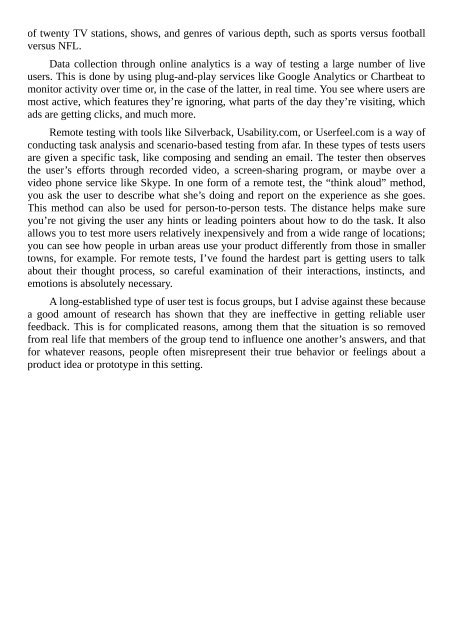Create successful ePaper yourself
Turn your PDF publications into a flip-book with our unique Google optimized e-Paper software.
of twenty TV stations, shows, and genres of various depth, such as sports versus football<br />
versus NFL.<br />
Data collection through online analytics is a way of testing a large number of live<br />
users. This is done by using plug-and-play services like Google Analytics or Chartbeat to<br />
monitor activity over time or, in the case of the latter, in real time. You see where users are<br />
most active, which features they’re ignoring, what parts of the day they’re visiting, which<br />
ads are getting clicks, and much more.<br />
Remote testing with tools like Silverback, Usability.com, or <strong>User</strong>feel.com is a way of<br />
conducting task analysis and scenario-based testing from afar. In these types of tests users<br />
are given a specific task, like composing and sending an email. The tester then observes<br />
the user’s efforts through recorded video, a screen-sharing program, or maybe over a<br />
video phone service like Skype. In one form of a remote test, the “think aloud” method,<br />
you ask the user to describe what she’s doing and report on the experience as she goes.<br />
This method can also be used for person-to-person tests. The distance helps make sure<br />
you’re not giving the user any hints or leading pointers about how to do the task. It also<br />
allows you to test more users relatively inexpensively and from a wide range of locations;<br />
you can see how people in urban areas use your product differently from those in smaller<br />
towns, for example. For remote tests, I’ve found the hardest part is getting users to talk<br />
about their thought process, so careful examination of their interactions, instincts, and<br />
emotions is absolutely necessary.<br />
A long-established type of user test is focus groups, but I advise against these because<br />
a good amount of research has shown that they are ineffective in getting reliable user<br />
feedback. This is for complicated reasons, among them that the situation is so removed<br />
from real life that members of the group tend to influence one another’s answers, and that<br />
for whatever reasons, people often misrepresent their true behavior or feelings about a<br />
product idea or prototype in this setting.


